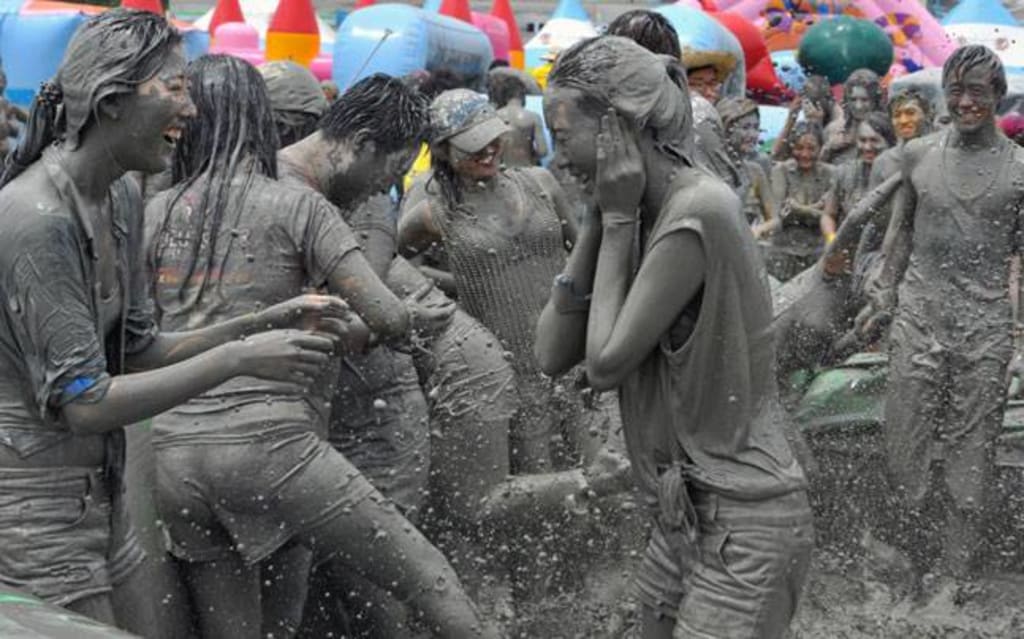Exploring the World's Most Unusual Traditional Practices: From Baby Jumping to Mud Festivals
A journey through diverse cultural customs that may seem strange, but are vital to the heritage and identity of communities around the globe

The world is full of diverse cultures and traditions, many of which may seem strange or unusual to outsiders. Here are a few examples of some of the most unusual traditional practices from around the world:
- The Takanakuy Festival in Peru: This annual festival, which takes place in the small Andean village of Chumbivilcas, involves community members settling disputes and grudges through a series of fist fights. Participants dress in brightly colored traditional clothing and engage in hand-to-hand combat, with the goal of resolving conflicts and restoring harmony within the community.
- The Baby-Throwing Festival in India: The village of Solapur in India holds an annual festival in which babies are thrown from a height of 50 feet to be caught by a group of men waiting with a cloth at the bottom. The festival is believed to bring good luck and prosperity to the babies and their families.
- The Kanamara Matsuri Festival in Japan: This annual festival, held in Kawasaki, celebrates the phallus as a symbol of fertility and prosperity. Participants parade through the streets carrying giant phallic statues and munch on phallic-shaped candies.
- The Bull Jumping Festival in Ethiopia: This ancient tradition, still practiced by the Hamar tribe in Ethiopia, involves young men jumping over a row of bull as a rite of passage into adulthood. The men are whipped by the tribe's women as they jump, and those who successfully complete the jump are considered to be initiated into manhood.
- The Mud Festival in South Korea: This annual festival, held in the city of Boryeong, involves participants covering themselves head-to-toe in mud. The mud is said to have therapeutic properties and the festival includes mud wrestling, mud sliding, and other mud-based activities.
- The Naki Sumo Festival in Japan: This annual festival, held in Tokyo, involves two men dressed in traditional sumo garb lifting and carrying babies, with the goal of making the babies cry. It is believed that the louder the baby cries, the more good luck and health they will have in the coming year.
- The Haka Dance in New Zealand: The Haka is a traditional dance performed by the Maori people of New Zealand. It is characterized by fierce facial expressions, stomping feet, and rhythmic body movements, and is usually performed as a war dance or a challenge to an opponent.
- The Night of the Radishes in Mexico: This annual festival, held in Oaxaca, Mexico, involves the carving of giant radishes into intricate sculptures. The sculptures are then displayed in a public square, where they are judged in a competition.
- The Body Painting Festival in Austria: This annual festival, held in the Austrian village of Klagenfurt, involves covering the human body in paint and then parading through the streets. The festival is a celebration of the human form and the human connection to nature.
- The Chinchero Festival in Peru: This annual festival, held in the village of Chinchero, Peru, involves a competition to see who can spin the most yarn in a single day. The festival is a celebration of the traditional Andean textile-making techniques.
- The El Colacho Baby Jumping Festival in Spain: This annual festival, held in the Spanish village of Castrillo de Murcia, involves men dressed as the devil jumping over babies born in the past year. It is believed that the practice brings good luck and protection to the babies.
- The Boryeong Mud Festival in South Korea: This annual festival, held in the city of Boryeong, features a variety of mud-based activities such as mud wrestling, mud sliding, and mud massages. The mud is said to have therapeutic properties and is believed to be good for the skin.
- The La Tomatina Festival in Spain: This annual festival, held in the town of Buñol, Spain, involves participants throwing tomatoes at each other in the streets. The festival is a celebration of the tomato harvest and has become a popular tourist attraction.
- The Day of the Dead in Mexico: The Day of the Dead is a traditional Mexican holiday that honors the deceased with offerings of food and drink, and colorful altars decorated with candles, flowers, and other decorations. The holiday is a time for families to remember and celebrate the lives of loved ones who have passed away.
- The Songkran Festival in Thailand: This annual festival, also known as the Thai New Year festival, features water fights in the streets as a way to wash away bad luck and bring good luck in the new year. The festival is celebrated with parades, traditional music, and other cultural activities.
While these traditions may seem strange or even bizarre to outsiders, they are an important part of the cultural heritage and identity of the communities that practice them. They are also a reminder of the diversity and richness of human culture and tradition.
If you find this piece interesting, please consider leaving a ❤️, or even a tip. Your support means a lot to me as a writer! You can also read more of my stories here
About the Creator
ansam yousry
Work as data engineer , experienced in data analyst and DWH , Write technical articles and share my life experience






Comments
There are no comments for this story
Be the first to respond and start the conversation.